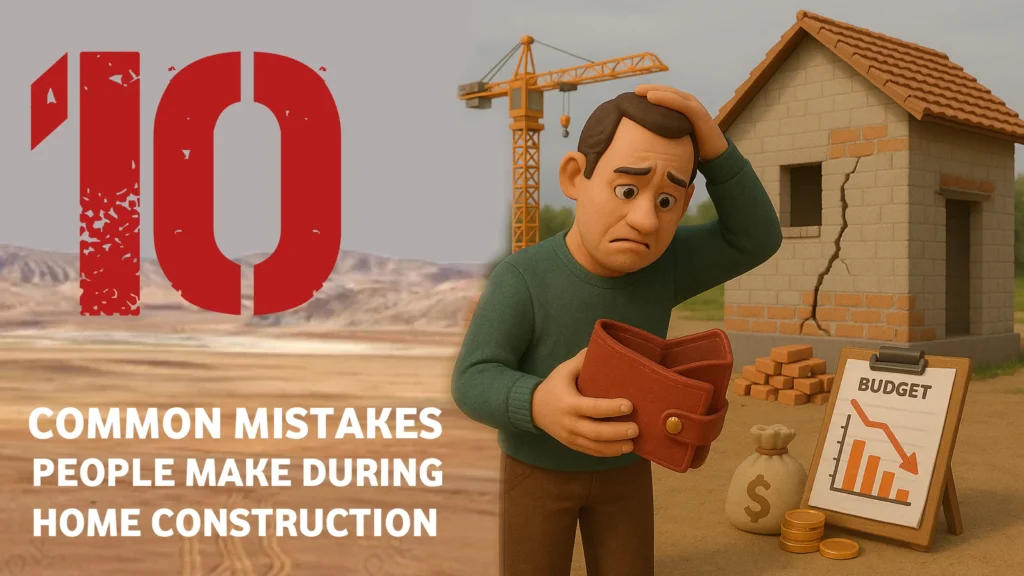
A complete step-by-step guide to building your dream home in India, covering everything from planning, budgeting, legal approvals, design, and construction to finishing touches—so you can start your project with confidence and avoid costly mistakes.
Step-by-Step Guide to Building Your Dream Home in India
For many Indians, owning a home isn’t just about shelter — it’s about security, pride, and creating a space that reflects who you are. Whether it’s a modest single-storey house in a small town or a luxury villa in a bustling city, the journey of building your own home is exciting… and sometimes overwhelming.
With so many steps involved — from finding the right land to choosing materials, managing contractors, and ensuring legal compliance — it’s easy to make mistakes that cost time and money.
This step-by-step guide to building your dream home in India will walk you through every stage in detail, so you can plan smartly, avoid costly mistakes, and turn your vision into reality.
By the end of this guide, you’ll know:
- Exactly what steps to follow (in order).
- How much it will cost at different quality levels.
- Which approvals and documents are required.
- How to select materials, contractors, and designs.
- How to avoid delays and scams.
👇 Let’s start Step-by-Step Guide to Building Your Dream Home in India
Step 1 – Define Your Budget & Financial Planning
Before you even think about buying land or designing your house, you need to know how much you can afford.
Average Construction Cost in India (2025)
Construction costs vary depending on location, material quality, and design complexity.
| Construction Quality | Cost per sq ft | For 1,000 sq ft Home |
|---|---|---|
| Basic Quality | ₹1,500 – ₹1,800 | ₹15 – ₹18 lakh |
| Standard Quality | ₹1,900 – ₹2,500 | ₹19 – ₹25 lakh |
| Premium Quality | ₹2,600 – ₹4,000+ | ₹26 – ₹40+ lakh |
Note: This is just the construction cost. It does not include land cost.
Hidden Costs You Must Account For
- Government approvals & registration: ₹50,000 – ₹2 lakh.
- Architect & engineering fees: 3%–8% of construction cost.
- Borewell/water connection: ₹50,000 – ₹2 lakh.
- Interior finishing & furniture: Can be 20–40% of total cost.
- Contingency fund: Keep at least 10% extra.
Funding Options
- Savings: Best if you want to avoid debt.
- Home Loan: Most Indian banks offer loans covering both plot purchase and construction.
- Loan Against Property: Useful if you already own land.
- Step-by-Step Loan Disbursal: Banks release funds at each stage of construction.
💡 Pro Tip: Use an Excel sheet or free budget planning tools like moneysmart to track expenses in real-time.
Step 2 – Choosing the Right Location
Location isn’t just about convenience — it affects your lifestyle, safety, and property value.
Things to Consider
- Connectivity: Distance from workplace, schools, hospitals, markets.
- Water & Electricity Supply: Avoid areas with frequent shortages.
- Neighborhood: Safety, cleanliness, noise levels.
- Future Growth: Will property prices rise in 5–10 years?
- Climate: Some areas require extra waterproofing or heat-resistant roofing.
💡 Example:
In 2025, land rates in Hyderabad outskirts may be ₹6,000/sq yd, while prime city areas can cost ₹40,000+/sq yd.
Step 3 – Buying the Plot (Legal & Registration Process)
Buying a plot in India requires thorough legal checks to avoid disputes later.
Must-Check Documents
- Title Deed: Confirms ownership.
- Encumbrance Certificate (EC): Ensures no pending loans or disputes.
- Khata / Patta Certificate: For property tax registration.
- RERA Registration: Especially for plotted developments.
Registration Process
- Draft sale agreement with seller.
- Pay stamp duty & registration charges.
- Register sale deed at sub-registrar’s office.
💡 Pro Tip: Hire a local property lawyer for verification — it’s worth the small fee.
You can also Read
Step 4 – Designing Your Dream Home
Once you own the land, it’s time to design.
Options
- Hire an Architect: Personalized designs; cost is 3–8% of construction.
- Use Ready-Made Plans: Cheaper, faster.
- Online Tools: AutoCAD, SketchUp, Floorplanner.
Key Considerations
- Vastu Shastra: Many Indian homeowners follow vastu for better energy flow.
- Future Expansion: Plan foundation for extra floors.
- Functionality: Adequate ventilation, natural light, storage space.
Step 5 – Getting Government Approvals
You cannot start construction without approvals.
Common Approvals
- Building Plan Approval (Municipal authority).
- Land Conversion Certificate (if agricultural land).
- Environmental clearance for large projects.
- NOC from water & electricity boards.
Step 6 – Choosing the Right Contractor / Builder
A good contractor can save you lakhs; a bad one can ruin your dream.
Tips to Select
- Check past projects.
- Verify licenses.
- Ask for references.
- Compare at least 3 quotes.
Types of Contracts
- Labor Contract: You buy materials, they provide labor.
- Turnkey Contract: Contractor handles everything.
👇 You can also Book our Services below
Step 7 – Material Selection & Procurement
Essential Materials & Recommended Brands
- Cement: UltraTech, ACC, Ambuja.
- Steel: TATA Tiscon, JSW, SAIL.
- Bricks/Blocks: AAC blocks for lightweight, red bricks for traditional.
- Flooring: Kajaria, Somany, Johnson Tiles.
- Paints: Asian Paints, Berger, Nerolac.
💡 Tip: Buy in bulk during off-season to save money.
Step 8 – Construction Phases Explained
a) Site Preparation – Clearing, leveling, fencing.
b) Foundation Work – Excavation, footing, waterproofing.
c) Structure & Framing – Columns, beams, slabs.
d) Walls & Roofing – Brick/AAC block walls, RCC or tile roofing.
e) Plumbing & Electrical – Concealed wiring, pipe layout.
f) Plastering & Flooring – Smooth finish, tiles/granite/marble.
g) Painting & Finishing – Primer, paint, waterproof coating.
h) Fixtures & Interiors – Kitchen, wardrobes, lights.
Step 9 – Quality Checks During Construction
- Foundation: No cracks, proper curing.
- Steel: Branded, rust-free.
- Plumbing: Leak tests before plastering.
- Electrical: Test circuits before fixing switches.
Step 10 – Final Touches & Moving In
- Deep clean.
- Fix curtains, lights, fans.
- Do griha pravesh (housewarming).
Bonus Tips
- Avoid mid-project design changes.
- Buy materials off-season for discounts.
- Visit site twice a week.
Common Mistakes to Avoid During Home Construction
❌ Not checking soil quality → Weak foundation.
❌ No written contract → Contractor delays work.
❌ Buying materials in small quantities → Higher cost.
💡 Example:
A family in Hyderabad had to rebuild their roof because they skipped waterproofing during monsoon season.
You can also Read
Estimated Cost Table (Example: 1,000 sq ft)
| Quality | Cost per sq ft | Total Cost |
|---|---|---|
| Basic | ₹1,500 | ₹15 lakh |
| Standard | ₹2,200 | ₹22 lakh |
| Premium | ₹3,200 | ₹32 lakh |
Conclusion
Building your dream home in India can be smooth and stress-free if you follow the right steps.
From budgeting to final touches, careful planning will help you save time, money, and frustration.
If you need construction guidance or contractor connections in your city, Home Fitting can help you start today.

